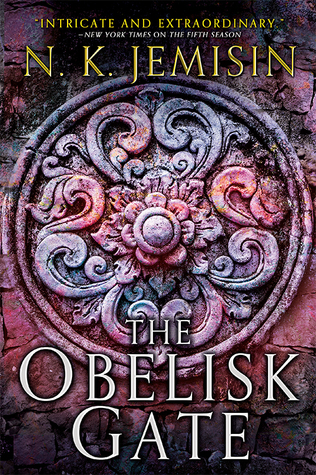The Obelisk Gate amplifies energies both physical and arcane. No single point of surface venting produces these energies in sufficient quantity. The Rift is a reliable, high-volume source.I didn't have the highest of hopes for The Obelisk Gate – as the middle volume of a trilogy, I expected it to feel more like a placeholder than a complete work of its own – and it ultimately satisfied my (lowered) expectations. After Fifth Season ended on a bit of a cliffhanger – Tell me, have you ever heard of something called a moon? – this book sees Alabaster explaining that cryptic question within its first hundred or so pages, and then we follow Essun (in the underground geode comm of Castrima) and her lost daughter Nassun (in the far-flung comm of Jekity and its quasi-Fulcrum), observe their deepening understandings and mounting powers for about a year, and then in the book's last fifty pages, the narrative rejoins the trilogy's overarching plot. Not much of real importance happens in this book compared to the first – it lacks the initial wonder of world-building (because the world is now familiar), there's less narrative tension (because the core mysteries have been revealed), and there's no literary twist (because that had been resolved) – but I still trust N. K. Jemisin to pull it all together in the end; this wasn't a waste of time, but didn't blow my mind. Spoilery from here.
Alabaster has learned what caused the Shattering that initiated the first of the humanity-crushing Fifth Seasons, and while his efforts so far to fix the problem is killing him, he has come to find Essun in order to teach her how to finish the job for him. Because a major theme of this series is the fear-based bigotry that the “stills” display towards the “roggas”, I really liked the irony of Alabaster having discovered that it was, indeed, the orogenes who first broke the world; that in order to fix it, 'Baster had to create the Rift that is currently killing off humanity. I had really enjoyed the conceit that orogenes are able to harness and redirect the energies of the Earth – the plausible explanation for the how behind the Fantasy – so I was annoyed when Alabaster revealed that this Earth-based stuff was just a power-limiting distraction imposed on orogenes by the Fulcrum; that their true strength lay in harnessing the silvery filaments of magic inherent in everything. I appreciate that the Earth of these books is our own planet, and that by using the word “magic” Jemisin is further tying her world to our own, but she could have introduced this greater power and called it anything but “magic” and I would have been on board. Now the Fantasy is just fantasy.
Over the course of the year within The Obelisk Gate, we watch Essun get involved with the politics of the comm that took her in, find out a bit more about the stone-eaters, and watch as she learns to harness the power of the obelisks. And again, I loved the irony of watching Essun transform into the monster that she spent an entire life protesting she could never be; the monster that the stills all knew she was capable of becoming.
“Not one more child!” You can sess the ones nearest you – the other council members, the screaming drunk, Penty and her girls, Hjarka and the rest, all of them. Everyone in Castrima. They trod upon the filaments of your nerves, tapping and jittering and they are Jija. You focus on the drunk woman and it is almost instinctual, the urge to begin squeezing the movement and life out of her and replacing that with whatever the by-product of magical reactions really is, the stuff that looks like stone. This stuff that is killing Alabaster, the father of your other dead child, NOT ONE MORE RUSTING CHILD. For how many centuries has the world killed rogga children so that everyone else's children can sleep easy? Everyone is Jija, the whole damn world is Schaffa, Castrima is Tirimo is the Fulcrum NOT ONE MORE and you turn with the obelisk torrenting its power through you to begin killing everyone within and beyond your sight.Meanwhile, we also see Nassun falling under Schaffa's control in Jekity, and while it's understandable that a little girl in her position would be grasping for love and approval anywhere she could find it, I never understood just what is going on with Schaffa's transformation (and not in a delightful frisson of narrative tension, but in an annoyed who-is-this-guy kind of way). By showing Nassun's mounting powers, her willingness to become a bit monstrous herself, her manipulation by both Schaffa and a stone-eater ally, and her inability to understand or forgive her mother, it would seem that Nassun and Essun will be on opposite sides during the final volume of the trilogy (or will they?).
The way of the world isn't the strong devouring the weak, but the weak deceiving and poisoning and whispering in the ears of the strong until they become weak, too. Then it's all broken hands and silver threads woven like ropes, and mothers who move the earth to destroy their enemies but cannot save one little boy.So, not enough really happened in this book – a lot about Castrima, that doesn't matter in the end; frequent brief scenes with minor characters (like Binof or Lerna or various stone-eaters) so they can be brought along to the finale – and I didn't get the further insight into the main characters or into the true history of the Earth that I would have liked. I do now understand(ish) where the stone-eaters came from and their ambivalent position in the behind-the-scenes war for control of the planet, but that didn't take much to explain. But again, not a waste of time, and I'm still looking forward to learning how it'll all conclude.
(Girl.)

